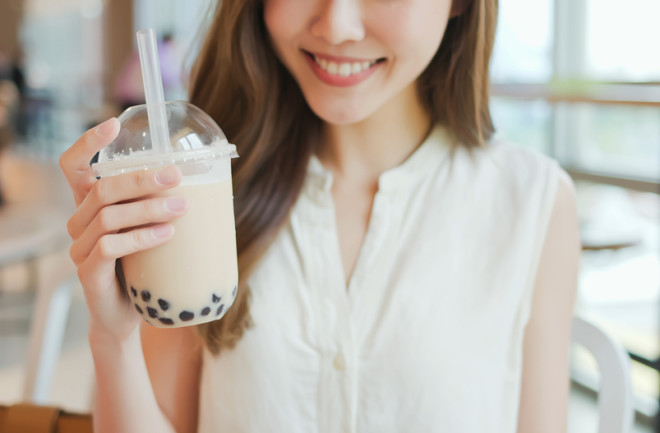The practice of drinking tea with milk has been around for centuries and enjoyed by many cultures throughout the world. Milk tea is said to have originated in China, where it remains one of the country’s — indeed one of Asia’s — most popular nonalcoholic drinks.
But in the 1980s, tea vendors in Taiwan began serving a novel variation of the beloved beverage. The milk tea was served ice-cold and combined with fen yuan, a traditional Taiwanese dessert made with ice, sugar, and small, sweet tapioca balls, also known as pearls or bubbles.
The drink became a sensation. By the 1990s and early 2000s, bubble tea — or boba, as it is more commonly known — spread around the world. Its popularity has only increased over time. The global boba tea business itself is currently valued at more than $2 billion annually, and expected to exceed $6 billion over the next decade.
The sweet, refreshing drink, with its wide range of textures and flavors, certainly tastes good, but is it good for you? Are there any health benefits to bubble tea? Before we can answer that, we should first look at how boba tea is made, and what ingredients it contains.
What Is Boba Made Of?
When a simple Google search for bubble tea recipes yields nearly 30 million results, it’s fair to say that there are a lot of different ways to prepare boba, but the basic ingredients of bubble tea include:
Tea
Traditionally, black tea was used to make bubble tea, but oolong, jasmine, green tea, matcha powder, and even herbal teas are sometimes used instead.
Milk
Of course, it wouldn’t be a milk tea without the milk. The amount used varies widely according to personal preference. In some recipes, bubble tea makers will add even more sweetness to the drink by swapping out regular milk and using half-and-half, condensed milk, or non-dairy creamer. Alternately, people who are sensitive to lactose may use oat, almond, coconut, or soy milk.
Sugar
Like milk, the amount of sugar or other sweeteners used will vary according to taste. Plain sugar, brown sugar, honey, and a variety of flavored syrups are all common ways to sweeten the drink to suit individual palates. For those wishing to avoid sugar, a sweetener like stevia is also a good option.
Boba Pearls
Most people refer to boba’s signature chewy spheres as tapioca pearls. While some bubble teas are indeed made with tapioca flour, traditional boba pearls are actually made from cassava flour.
To be clear, both kinds of flour are made from the root of the cassava plant, but tapioca flour is made only from the starchy part of the vegetable, while cassava flour uses the whole root. As a result, this flour is higher in fiber than tapioca and generally considered to be healthier and more nutrient-dense.
However, that may be an exceedingly relative distinction, since boba pearls made from either type of flour are typically soaked in very sweet syrup to give them flavor. In lieu of traditional pearls, some boba drinkers prefer to substitute with bits of fruit.
Read More: 5 Natural Remedies To Boost Health
Is Boba Healthy?
You may get some beneficial antioxidants from the tea in boba, and if the bubbles or pearls are made the traditional way, from cassava flour, you’re only adding to your antioxidant intake. Cassava flour is also a good source of vitamin C and other vitamins and minerals. And both cassava and tapioca flour are gluten-free flour to boot, so compared to regular flour they’re much easier on your digestive system, especially if you’re sensitive to gluten.
But those considerations don’t outweigh the fact that boba tea is generally made with a lot of sugar — especially when you add flavored syrups, honey, jelly, and more. According to a USDA fact sheet that looked at one brand, an 8-ounce serving of boba contains 120 calories and 1.5 grams of fat. That doesn’t sound so bad, except that other brands may contain much more, and most people seldom restrict themselves to a mere cup of boba.
It doesn’t help that shops and stands tend to serve boba in 16- and even 24-ounce sizes — the calorie-load on that drink would be about equivalent to eating two candy bars. You can moderate the calorie hit somewhat by ordering low-sugar options, or requesting fewer boba pearls, but you’ll still get a good jolt of calories and sugar from the drink, something that people with diabetes or healthy weight goals need to bear in mind.
Bottom line: Given that boba tea is a combination of sweet milk tea and a favorite Taiwanese dessert, it would be a stretch to call the beverage a health drink. For this reason, nutrition experts generally recommend drinking boba in moderation — as a treat, not as your everyday pick-me-up. Hope that didn’t burst anyone’s bubble.
Read More: What Science Says About the Potential Health Benefits of Kombucha
Article Sources
Our writers at Discovermagazine.com use peer-reviewed studies and high quality sources for our articles, and our editors review for scientific accuracy and editorial standards. Review the sources used below for this article:
Dictionary.com. Boba Definition and Meaning
Bloomberg.com. How Taiwanese Bubble Tea Has Taken Over the U.S.
Cleveland Clinic: Health Essentials. How Black Tea Can Benefit Your Health
Journal of Evidence-Based Integrative Medicine. Cassava (Manihot esculenta Crantz): A Systematic Review for the Pharmacological Activities, Traditional Uses, Nutritional Values, and Phytochemistry
Harvard T.H. Chan School of Public Health: The Nutrition Source: Antioxidants
Food Science & Nutrition. Study on quality characteristics of cassava flour and cassava flour short biscuits
USDA: FoodData Central. Boba, Bubble Tea, Green Tea, Lychee Bobas
Food Science & Nutrition. Calories and sugars in boba milk tea: implications for obesity risk in Asian Pacific Islanders

